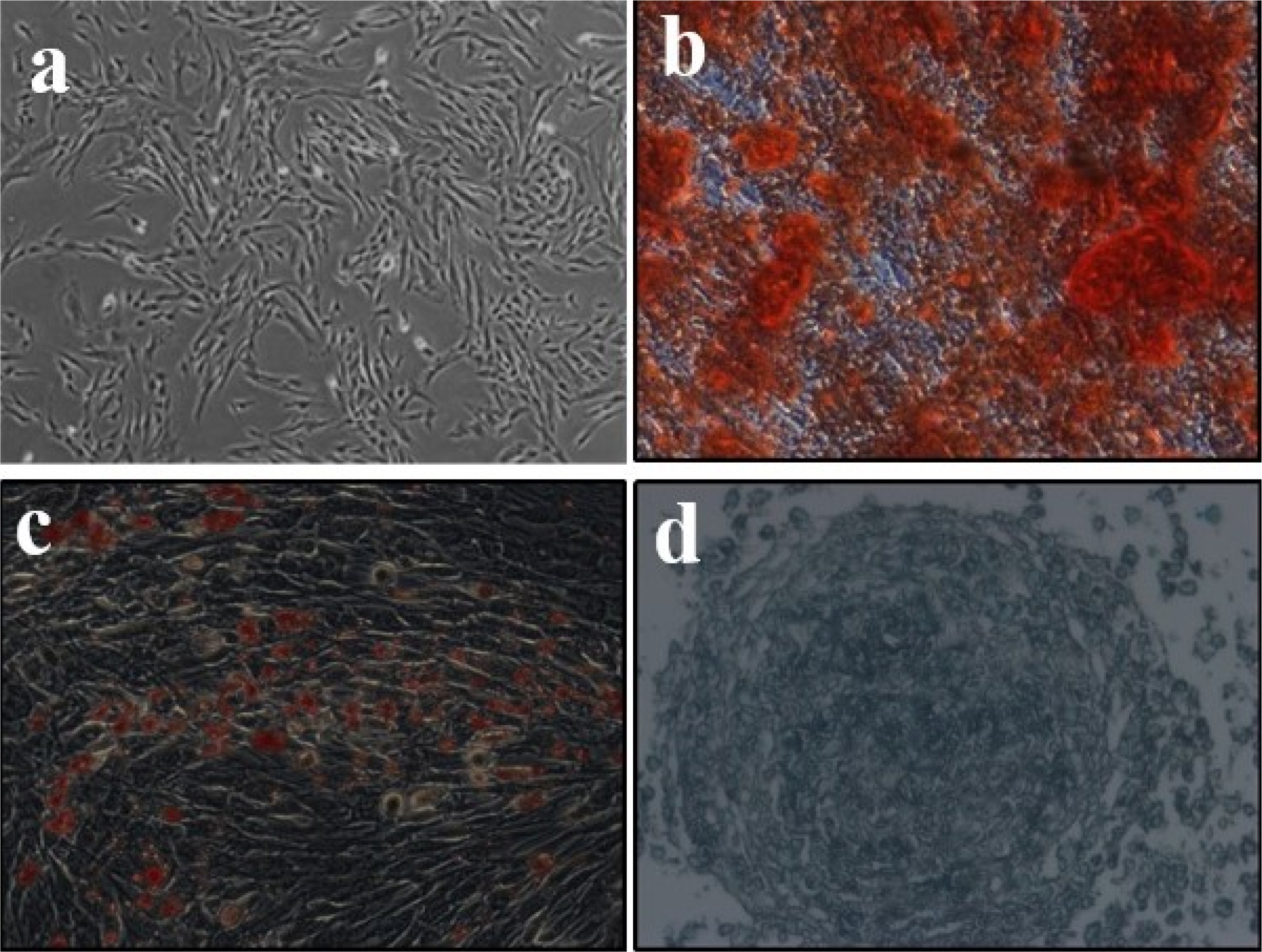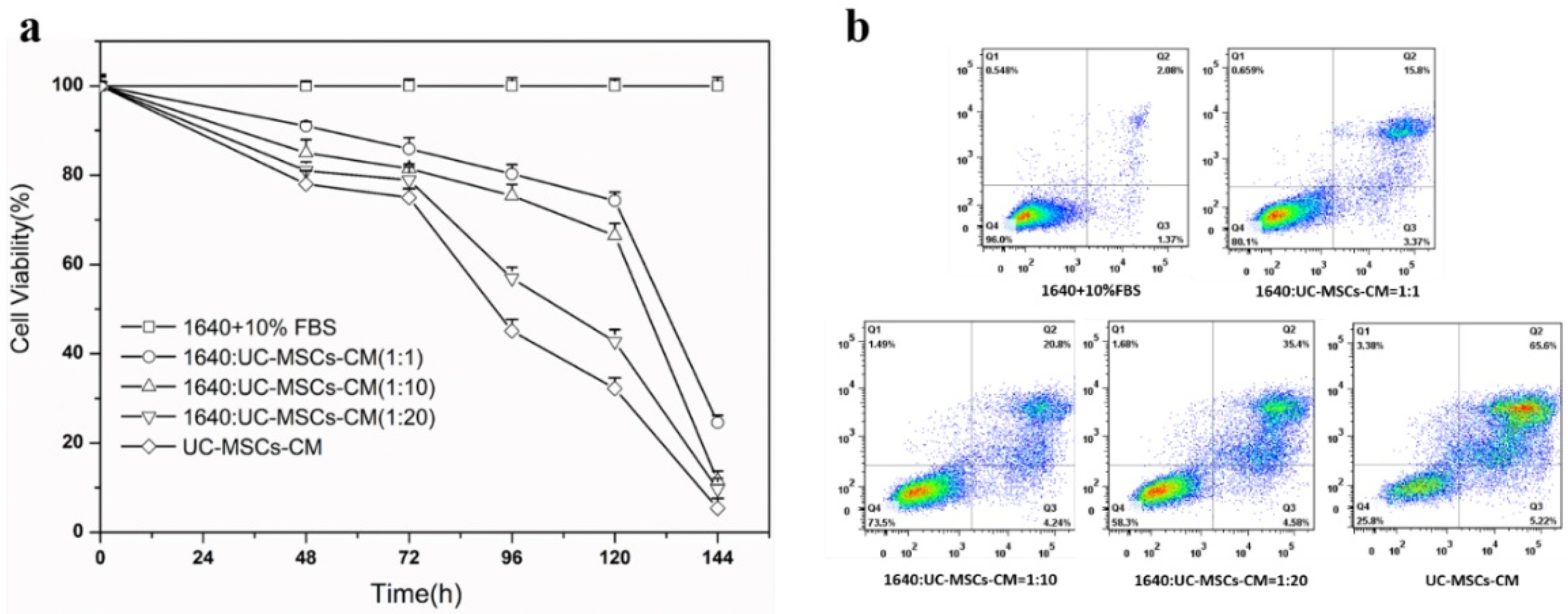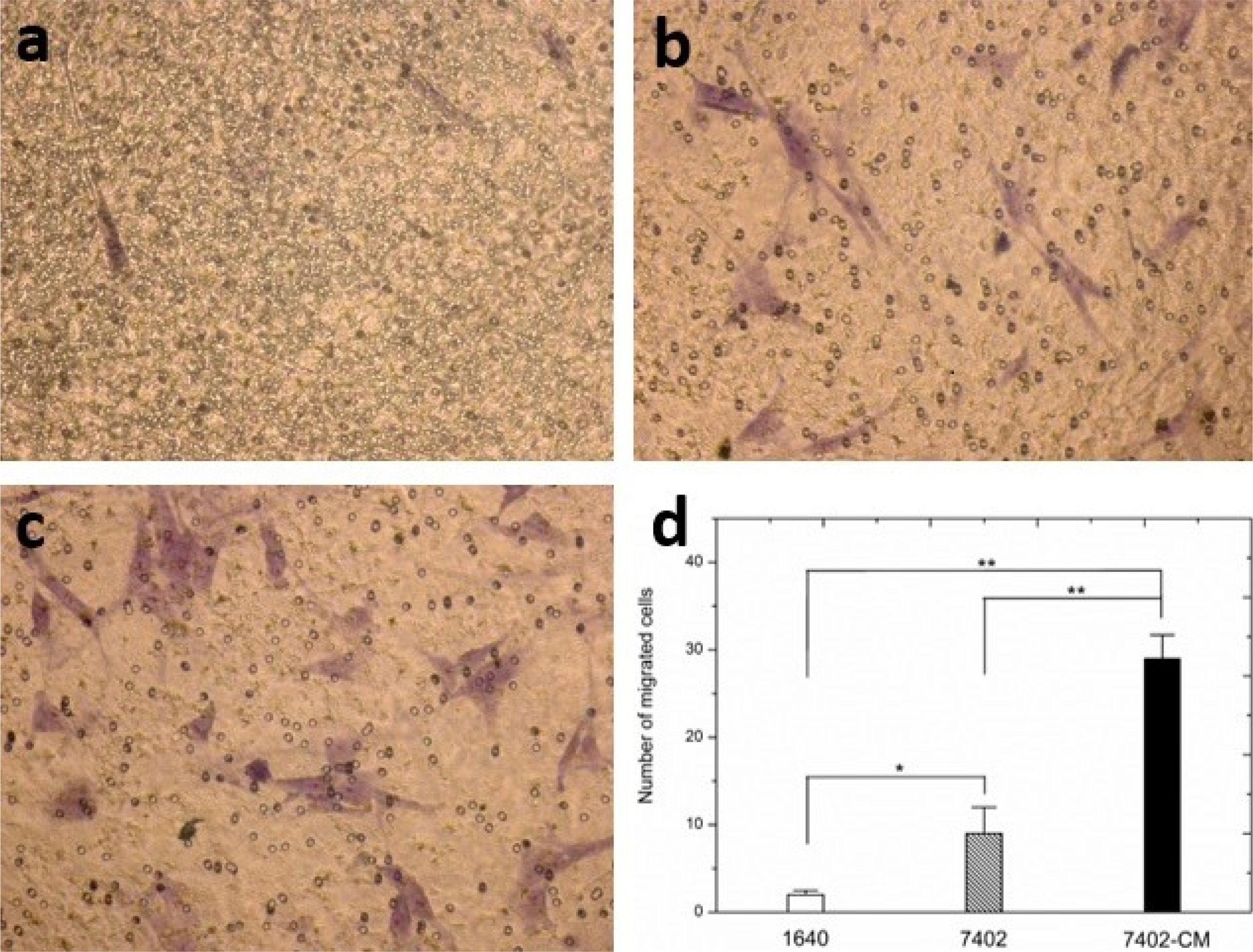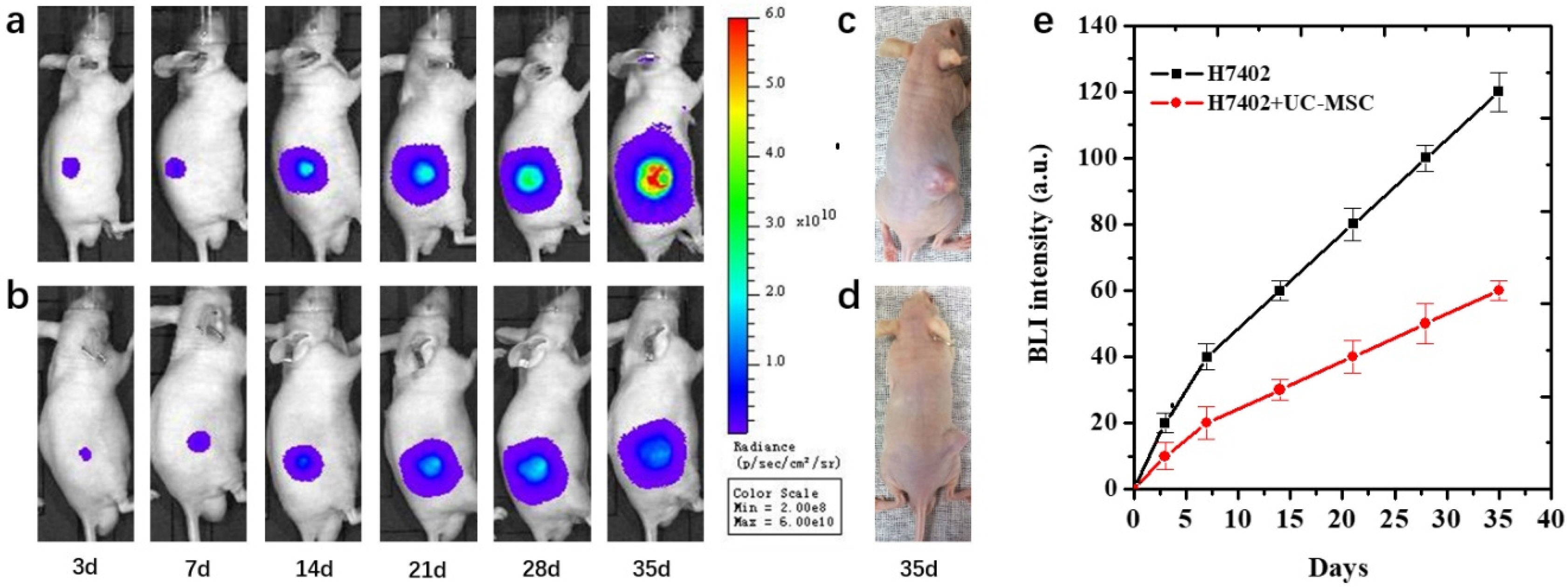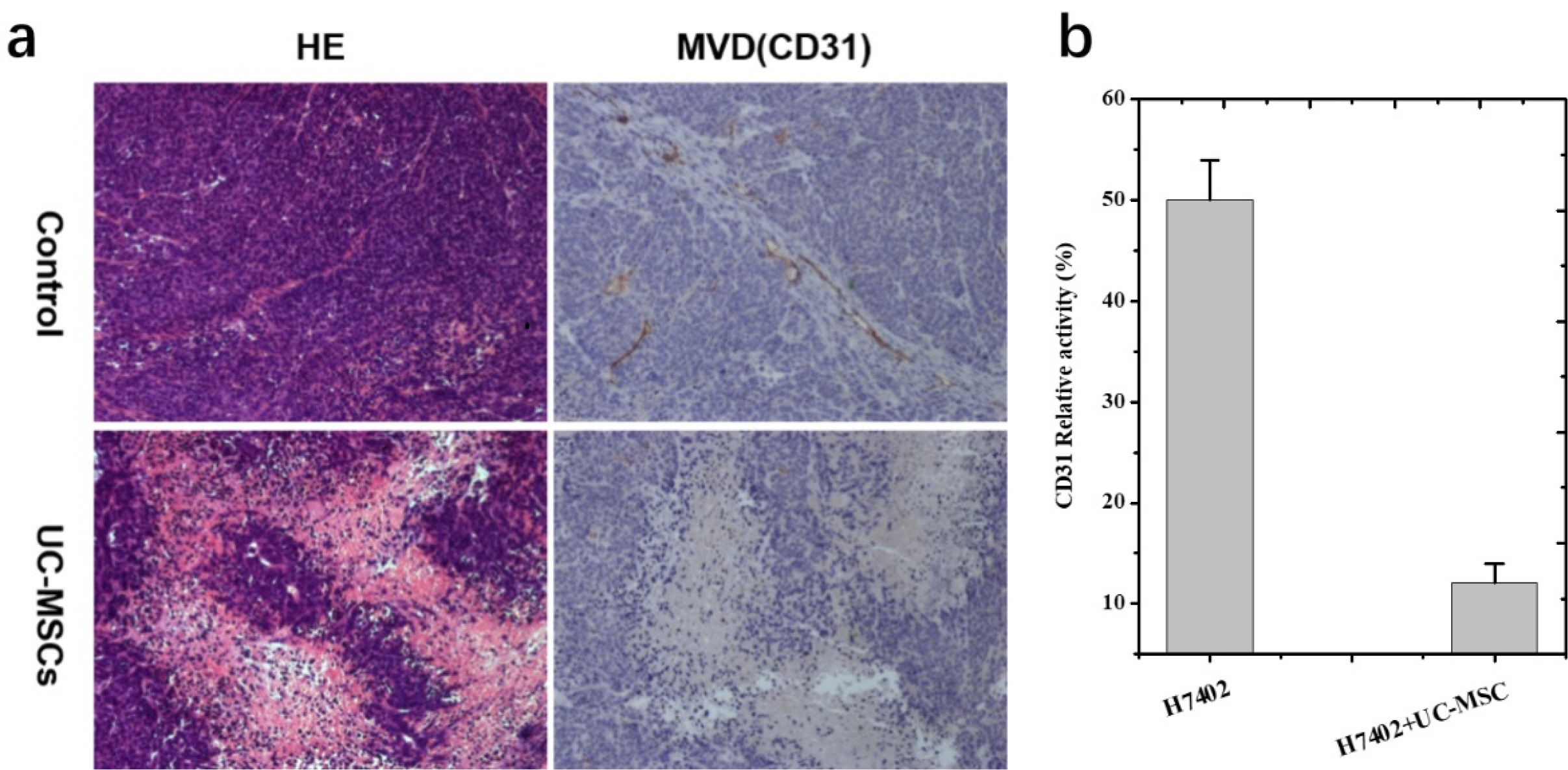Int J Stem Cells.
2020 Mar;13(1):104-115. 10.15283/ijsc19098.
Quantitative Tracking Tumor Suppression Efficiency of Human Umbilical Cord-Derived Mesenchymal Stem Cells by Bioluminescence Imaging in Mice Hepatoma Model
- Affiliations
-
- 1Department of MRI, The First Affiliated Hospital of Zhengzhou University, Zhengzhou, China
- 2Department of Pathology, The First Affiliated Hospital of Zhengzhou University, Zhengzhou, China
- KMID: 2500570
- DOI: http://doi.org/10.15283/ijsc19098
Abstract
- Background and Objectives
Tracking of the tumor progression by MSCs-based therapy is being increasingly important in evaluating relative therapy effectively. Herein, Bioluminescence imaging (BLI) technology was used to dynamically and quantitatively track the hepatocellular carcinoma suppressive effects by human umbilical cord mesenchymal stem cells (UC-MSCs).
Methods and Results
The stem cells present typical phenotypic characteristics and differentiation ability by morphology and flow cytometry analysis of marker expression. Then, the growth inhibition effect of conditioned medium and UC-MSC on H7402 cells was studied. It is found both the conditioned medium and UC-MSC can effectively decrease the proliferation of H7402 cells compared with the control group. Meanwhile, the relative migration of UC-MSC to H7402 is also increased through the transwell migration assay. In addition, a mice hepatoma tumor model was built by H7402 cells which can express a pLenti-6.3/DEST-CMV-luciferase 2-mKate2 gene. The effect of stem cells on growth inhibition of tumor in a mice transplantation model was dynamically monitored by bioluminescence imaging within 5 weeks. It has shown the bioluminescence signal intensity of the tumor model was significantly higher than that of the UC-MSC co-acting tumor model, indicating that the inhibition of UC-MSC on liver cancer resulted in low expression of bioluminescent signals.
Conclusions
The microenvironment of UC-MSCs can effectively inhibit the growth of liver cancer cells, and this therapeutic effect can be dynamically and quantitatively monitored in vivo by BLI. This is of great significance for the imaging research and application of stem cells in anticancer therapy.
Keyword
Figure
Reference
-
References
1. Arthur A, Zannettino A, Gronthos S. 2009; The therapeutic applications of multipotential mesenchymal/stromal stem cells in skeletal tissue repair. J Cell Physiol. 218:237–245. DOI: 10.1002/jcp.21592. PMID: 18792913.
Article2. Godwin EE, Young NJ, Dudhia J, Beamish IC, Smith RK. 2012; Implantation of bone marrow-derived mesenchymal stem cells demonstrates improved outcome in horses with overstrain injury of the superficial digital flexor tendon. Equine Vet J. 44:25–32. DOI: 10.1111/j.2042-3306.2011.00363.x. PMID: 21615465.
Article3. Csaki C, Schneider PR, Shakibaei M. 2008; Mesenchymal stem cells as a potential pool for cartilage tissue engineering. Ann Anat. 190:395–412. DOI: 10.1016/j.aanat.2008.07.007. PMID: 18842397.
Article4. Qin J, Zhao Y, Wang Y, Betzler C, Popp F, Sen Gupta A, Augsburger D, Camaj P, Nelson P, Bruns C. 2016; Therapeutic potential of mesenchymal stem cells in gastrointestinal cancers - current evidence. Gastrointest Cancer. 6:41–47. DOI: 10.2147/GICTT.S54121.5. Niess H, Bao Q, Conrad C, Zischek C, Notohamiprodjo M, Schwab F, Schwarz B, Huss R, Jauch KW, Nelson PJ, Bruns CJ. 2011; Selective targeting of genetically engineered mesenchymal stem cells to tumor stroma microenvironments using tissue-specific suicide gene expression suppresses growth of hepatocellular carcinoma. Ann Surg. 254:767–774. discussion 774-775. DOI: 10.1097/SLA.0b013e3182368c4f. PMID: 22042469.
Article6. Zhu W, Xu W, Jiang R, Qian H, Chen M, Hu J, Cao W, Han C, Chen Y. 2006; Mesenchymal stem cells derived from bone marrow favor tumor cell growth in vivo. Exp Mol Pathol. 80:267–274. DOI: 10.1016/j.yexmp.2005.07.004. PMID: 16214129.
Article7. Nakamizo A, Marini F, Amano T, Khan A, Studeny M, Gumin J, Chen J, Hentschel S, Vecil G, Dembinski J, Andreeff M, Lang FF. 2005; Human bone marrow-derived mesenchymal stem cells in the treatment of gliomas. Cancer Res. 65:3307–3318. DOI: 10.1158/0008-5472.CAN-04-1874. PMID: 15833864.
Article8. Kidd S, Caldwell L, Dietrich M, Samudio I, Spaeth EL, Watson K, Shi Y, Abbruzzese J, Konopleva M, Andreeff M, Marini FC. 2010; Mesenchymal stromal cells alone or expressing interferon-beta suppress pancreatic tumors in vivo, an effect countered by anti-inflammatory treatment. Cytotherapy. 12:615–625. DOI: 10.3109/14653241003631815. PMID: 20230221.
Article9. Maestroni GJ, Hertens E, Galli P. 1999; Factor(s) from nonmacrophage bone marrow stromal cells inhibit Lewis lung carcinoma and B16 melanoma growth in mice. Cell Mol Life Sci. 55:663–667. DOI: 10.1007/s000180050322. PMID: 10357234.
Article10. Li L, Neaves WB. 2006; Normal stem cells and cancer stem cells: the niche matters. Cancer Res. 66:4553–4557. DOI: 10.1158/0008-5472.CAN-05-3986. PMID: 16651403.
Article11. Brücher BL, Jamall IS. 2014; Cell-cell communication in the tumor microenvironment, carcinogenesis, and anticancer treatment. Cell Physiol Biochem. 34:213–243. DOI: 10.1159/000362978. PMID: 25034869.
Article12. Camorani S, Hill BS, Fontanella R, Greco A, Gramanzini M, Auletta L, Gargiulo S, Albanese S, Lucarelli E, Cerchia L, Zannetti A. 2017; Inhibition of bone marrow-derived mesenchymal stem cells homing towards triple-negative breast cancer microenvironment using an anti-PDGFRβ aptamer. Theranostics. 7:3595–3607. DOI: 10.7150/thno.18974. PMID: 28912898. PMCID: PMC5596446.
Article13. Arutyunyan I, Elchaninov A, Makarov A, Fatkhudinov T. 2016; Umbilical cord as prospective source for mesenchymal stem cell-based therapy. Stem Cells Int. 2016:6901286. DOI: 10.1155/2016/6901286. PMID: 27651799. PMCID: PMC5019943.
Article14. Patel DM, Shah J, Srivastava AS. 2013; Therapeutic potential of mesenchymal stem cells in regenerative medicine. Stem Cells Int. 2013:496218. DOI: 10.1155/2013/496218. PMID: 23577036. PMCID: PMC3615627.
Article15. Sadikot RT, Blackwell TS. 2008; Bioluminescence: imaging modality for in vitro and in vivo gene expression. Methods Mol Biol. 477:383–394. DOI: 10.1007/978-1-60327-517-0_29. PMID: 19082962.
Article16. Jelicks LA, Lisanti MP, Machado FS, Weiss LM, Tanowitz HB, Desruisseaux MS. 2013; Imaging of small-animal models of infectious diseases. Am J Pathol. 182:296–304. DOI: 10.1016/j.ajpath.2012.09.026. PMID: 23201133. PMCID: PMC3969504.
Article17. de Almeida PE, van Rappard JR, Wu JC. 2011; In vivo bioluminescence for tracking cell fate and function. Am J Physiol Heart Circ Physiol. 301:H663–H671. DOI: 10.1152/ajpheart.00337.2011. PMID: 21666118. PMCID: PMC3191083.
Article18. Negrin RS, Contag CH. 2006; In vivo imaging using bioluminescence: a tool for probing graft-versus-host disease. Nat Rev Immunol. 6:484–490. DOI: 10.1038/nri1879. PMID: 16724101.
Article19. Bhaumik S, Gambhir SS. 2002; Optical imaging of Renilla luciferase reporter gene expression in living mice. Proc Natl Acad Sci U S A. 99:377–382. DOI: 10.1073/pnas.012611099. PMID: 11752410. PMCID: PMC117568.
Article20. Chang M, Anttonen KP, Cirillo SL, Francis KP, Cirillo JD. 2014; Real-time bioluminescence imaging of mixed mycobacterial infections. PLoS One. 9:e108341. DOI: 10.1371/journal.pone.0108341. PMID: 25265287. PMCID: PMC4180448.
Article21. Ayatollahi M, Geramizadeh B, Zakerinia M, Ramzi M, Yaghobi R, Hadadi P, Rezvani AR, Aghdai M, Azarpira N, Karimi H. 2012; Human bone marrow-derived mesenchymal stem cell: a source for cell-based therapy. Int J Organ Transplant Med. 3:32–41. PMID: 25013621. PMCID: PMC4089277.22. Li M, Ikehara S. 2013; Bone-marrow-derived mesenchymal stem cells for organ repair. Stem Cells Int. 2013:132642. DOI: 10.1155/2013/132642. PMID: 23554816. PMCID: PMC3608346.
Article23. Sun B, Yu KR, Bhandari DR, Jung JW, Kang SK, Kang KS. 2010; Human umbilical cord blood mesenchymal stem cell-derived extracellular matrix prohibits metastatic cancer cell MDA-MB-231 proliferation. Cancer Lett. 296:178–185. DOI: 10.1016/j.canlet.2010.04.007. PMID: 20435406.
Article24. Hollweck T, Hagl C, Eissner G. 2012; Mesenchymal stem cells from umbilical cord tissue as potential therapeutics for cardiomyodegenerative diseases - a review. Int J Mol Cell Med. 1:119–132. PMID: 24551768. PMCID: PMC3920507.25. Hemming AW, Berumen J, Mekeel K. 2016; Hepatitis B and hepatocellular carcinoma. Clin Liver Dis. 20:703–720. DOI: 10.1016/j.cld.2016.06.007. PMID: 27742009.
Article26. Liu Y, Guo X, Wu L, Yang M, Li Z, Gao Y, Liu S, Zhou G, Zhao J. 2016; Lipid rafts promote liver cancer cell proliferation and migration by up-regulation of TLR7 expression. Oncotarget. 7:63856–63869. DOI: 10.18632/oncotarget.11697. PMID: 27588480. PMCID: PMC5325409.
Article27. Stoltz A, Gagnière J, Dupré A, Rivoire M. 2014; Radiofrequency ablation for colorectal liver metastases. J Visc Surg. 151(Suppl 1):S33–S44. DOI: 10.1016/j.jviscsurg.2013.12.005. PMID: 24582728.
Article28. Carnaghi C, Chiti A, Marzo K, Rodari M, Rimassa L, Tronconi MC, Santoro A. 2005; 18F-FDG-PET (PET) and contrast-enhanced CT-scan (CT) in the evaluation of liver metastases from colorectal cancer after chemotherapy. J Clin Oncol. 16:3713–3717. DOI: 10.1200/jco.2005.23.16_suppl.3710.29. Schwartz JM, Ham JM. 2003; Treatment of hepatocellular carcinoma. Curr Treat Options Gastroenterol. 6:402. DOI: 10.1007/s11938-003-0048-z. PMID: 14585235.
Article30. Liu JJ, Hu XJ, Li ZR, Yan RH, Li D, Wang J, Shan H. 2017; In vivo bioluminescence imaging of transplanted mesenchymal stromal cells and their rejection mediated by intrahepatic nk cells. Mol Imaging Biol. 19:31–40. DOI: 10.1007/s11307-016-0962-9. PMID: 27406089.
Article31. Salehinejad P, Alitheen NB, Ali AM, Omar AR, Mohit M, Janzamin E, Samani FS, Torshizi Z, Nematollahi-Mahani SN. 2012; Comparison of different methods for the isolation of mesenchymal stem cells from human umbilical cord Wharton's jelly. In Vitro Cell Dev Biol Anim. 48:75–83. DOI: 10.1007/s11626-011-9480-x. PMID: 22274909.
Article32. Bajetto A, Pattarozzi A, Corsaro A, Barbieri F, Daga A, Bosio A, Gatti M, Pisaturo V, Sirito R, Florio T. 2017; Different effects of human umbilical cord mesenchymal stem cells on glioblastoma stem cells by direct cell interaction or via released soluble factors. Front Cell Neurosci. 11:312. DOI: 10.3389/fncel.2017.00312. PMID: 29081734. PMCID: PMC5645520.
Article33. Bishayee A. 2014; The role of inflammation and liver cancer. Adv Exp Med Biol. 816:401–435. DOI: 10.1007/978-3-0348-0837-8_16. PMID: 24818732.34. Dennert G, Horneber M. 2006; Selenium for alleviating the side effects of chemotherapy, radiotherapy and surgery in cancer patients. Cochrane Database Syst Rev. (3):CD005037. DOI: 10.1002/14651858.CD005037.pub2. PMID: 16856073. PMCID: PMC6464502.
Article35. Daher S, Massarwa M, Benson AA, Khoury T. 2018; Current and future treatment of hepatocellular carcinoma: an updated comprehensive review. J Clin Transl Hepatol. 6:69–78. DOI: 10.14218/JCTH.2017.00031. PMID: 29607307. PMCID: PMC5863001.
Article36. Shen CJ, Chan TF, Chen CC, Hsu YC, Long CY, Lai CS. 2016; Human umbilical cord matrix-derived stem cells expressing interferon-β gene inhibit breast cancer cells via apoptosis. Oncotarget. 7:34172–34179. DOI: 10.18632/oncotarget.8997. PMID: 27129156. PMCID: PMC5085146.
Article37. Lee SI, Catalano OA, Dehdashti F. 2015; Evaluation of gynecologic cancer with MR imaging, 18F-FDG PET/CT, and PET/MR imaging. J Nucl Med. 56:436–443. DOI: 10.2967/jnumed.114.145011. PMID: 25635136.
Article38. Spötl L, Sarti A, Dierich MP, Möst J. 1995; Cell membrane labeling with fluorescent dyes for the demonstration of cytokine-induced fusion between monocytes and tumor cells. Cytometry. 21:160–169. DOI: 10.1002/cyto.990210208. PMID: 8582236.
Article39. Zhang Y, Shi Y, Bai J, Zhang L, Yang Y, Cheng J. 2015; Functional investigation of effects on transplantable bone marrow stem cells label with iron oxide nanoparticles. J Biomater Tissue Eng. 5:486–492. DOI: 10.1166/jbt.2015.1298.
Article40. Lv H, Wang C, Fang T, Li T, Lv G, Han Q, Yang W, Wang H. 2018; Vitamin C preferentially kills cancer stem cells in hepatocellular carcinoma via SVCT-2. NPJ Precis Oncol. 2:1. DOI: 10.1038/s41698-017-0044-8. PMID: 29872720. PMCID: PMC5871898.
Article
- Full Text Links
- Actions
-
Cited
- CITED
-
- Close
- Share
- Similar articles
-
- The Therapeutic Effects of Exosomes Derived from Human Umbilical Cord Mesenchymal Stem Cells on Scleroderma
- In Vivo Cell Tracking with Bioluminescence Imaging
- Differentiation of Osteoblast Progenitor Cells from Human Umbilical Cord Blood
- In vivo Tracking of Transplanted Bone Marrow-Derived Mesenchymal Stem Cells in a Murine Model of Stroke by Bioluminescence Imaging
- Percutaneous transplantation of human umbilical cord-derived mesenchymal stem cells in a dog suspected to have fibrocartilaginous embolic myelopathy

